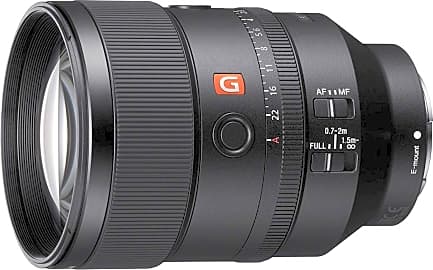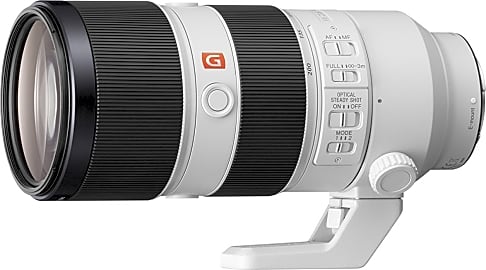The 10 Best Sony Lenses

This wiki has been updated 37 times since it was first published in June of 2016. For all you shutterbugs out there who rely on Sony cameras and are ready to add a new dimension to your photography, check out our selection of the company's finest lenses. Each one is specifically designed to give you an ideal focal length and aperture for capturing stunning portraits, landscapes, wildlife shots, or fast-moving action, ranked here by sharpness, performance, and versatility. When users buy our independently chosen editorial choices, we may earn commissions to help fund the Wiki.
Editor's Notes
August 05, 2020:
Sony's come out with a handful of new lenses since our last visit to this ranking, but the two that stood out the most and made their way onto our list were the FE 12-24mm f/2.8 G Master and the FE 35mm f/1.8, the latter of which replaces the previously included 35mm f/2.8, which had both a slower maximum aperture and a smaller light collecting area, without there being a huge difference in price. In the case of the 12-24mm, that lens, combined with the FE Standard GM 24-70mm f/2.8 and the FE GM 70-200mm f/2.8, finally gives Sony shooters a viable Holy Trinity, as seen in Nikon and Canon lens lineups.
This trinity starts at a wide focal length, (11mm in Canon's case, 14mm in Nikon's) and extends out to 200mm over the course of three lenses, each one picking up where the one before it left off. It's an ideal set for event shooters, especially wedding photographers who need to cover everything from tight church interiors to "the kiss" as caught from a distance.
To make room for those two new lenses, we sent off the old 35mm, as well as the FE 55mm ƒ/1.8, which, despite its Zeiss glass and good price, felt redundant in the presence of the superior Planar FE 50mm f/1.4 ZA, which is a tad wider and undeniably faster, but that also boasts a larger front element to collect more light and significantly increase its low-light performance.
June 17, 2019:
With a few new offerings from Sony, a small number of our previously included lenses saw their spots zapped up by superior glass. The 24mm f/1.8 on our old list, for example, has been replaced by a 24mm f/1.4. That small a difference in aperture may not seem like much, but it also signals a different approach to the build of the lens, which falls into Sony's G series and is undoubtedly built to their highest specifications. We also said goodbye to the 20mm pancake lens that used to live at number ten. It made it onto our last list by the skin of its teeth, and though it's convenient for its size and weight, its image quality ultimately left something to be desired. Sony also came out with an exceptional 600mm prime for sports and wildlife shooters, with a fast f/4 aperture, but it comes in with a hefty price tag, so we included it in our special honors section for its quality and performance, but thought it wouldn't make sense in a field of pro-level glass that runs a tenth of that price on average.
Special Honors
FE 600mm ƒ/4 GM Super For sports and wildlife shooters who need to get particularly close to the action, this massive telephoto option boasts a fast ƒ/4 aperture that's great for dimly lit arenas and nighttime exteriors. It's an enormous piece of glass, however, so you'll definitely need a good tripod to stabilize it, and it's rather expensive. sony.com
Through The Looking Glass
With the right lens in place, your images will go from family photo quality, to professional grade.
Photographers at the enthusiast level spend an inordinate amount of time focusing on the specs on their camera bodies, and significantly less time concerned with the quality of their lenses. For consumers making the jump to a higher level camera from exclusively using their cell phone or a small, digital point-and-shoot for their photography, any lens, by virtue of its size increase alone, will seem far superior.
The question for a real photographer, or for anyone aspiring to capture truly great images, isn't one of resolution and megapixels, nor is it one of burst rate or autofocus points. It must be a question of image quality.
There is no more potent variable in the quest for image quality than the lens. A manufacturer can pack enough megapixels onto a tiny sensor and connect it to a powerful enough device to capture decent images through a small, poorly made lens (see: every cell phone in existence), but the ceiling to that quality is low and definite.
You may have heard of a move called Tangerine, which gained a tremendous amount of press in one circle for the fact that it starred a transgender actress, and an equally potent amount of coverage in another circle because it was shot entirely on an iPhone. What was left out of a lot of the latter coverage, however, was director Sean S. Baker's admission that the film never would have looked as good as it did if he hadn't used an anamorphic lens kit prototype by Moondog Labs. The lens on the phone itself wouldn't cut it.
Sony shooters can rest assured that they have some of the best sensor technology in their camera bodies, with some of the fastest, most reliable autofocusing out there. With the right lens in place, your images will go from family photo quality, to professional grade.
Start With The Mount
Before looking more deeply into the speeds and focal lengths of the lenses on our list, there's an important distinction between lenses made for Sony mounts, and others that plenty of Sony shooters use, but that require adapters. In general, we advise against using lenses outside of your system unless there is an undeniable increase in quality. If you had, say, a Leica 50mm Noctilux-M lens it'd probably be worth using it over pretty much anything else in the world. In the absence of anything that special, it's best to stick to what fits.
In the absence of anything that special, it's best to stick to what fits.
From that point on, the major questions you have to answer involve focal length and aperture speed. As for focal length, this depends a lot on what kind of shooter you are. A lens with a variable focal length, more commonly known as a zoom lens, will let you see more or less of a scene from closer or farther away without having you move your body an inch. These are particularly useful for capturing family sporting events and wildlife.
Fixed focal length lenses, called primes, tend to be sharper simply because manufacturers only have to account for sharpness at the one focal length, instead of having to distribute it across many points. If you want to get closer or farther away with these you actually have to move, making them superior for landscape and portrait photography.
The focal length itself tells you how much of a given scene your lens can capture. A smaller number preceding the mm measurement is a wider angle that will cover more space. These are much better indoors, especially at parties, where you have to shoot very close to your subjects. A larger number will let you capture subjects that are much farther away with great clarity, but they limit your ability to capture large scenes or action that's happening close to you.
That other number you'll see on every lens, the one that usually written as: ƒ/2.8 or 2.8-5.6 is a measurement of the width through which light can enter the lens. I'll save you a long mathematical explanation and simply tell you that, in almost every case, the smaller that number is, the better.
Better Blooming Late Than Never
The technology behind the camera lens reaches back to at least the 5th century BCE, when we find the earliest reference to a stone used for magnification, specifically in this case to focus sunlight on kindling as a fire starter. Those stones were refined through the years to become the magnifying glasses we would recognize today, but their design helped the early innovators of the camera to capture the first still images on record.
With those tools at their fingertips, the company invested heavily in its D-SLR line, leading to the high quality A-mount lenses on our list.
Sony, by comparison, has come to the game relatively late. Its share of the digital camera market in the late 1990s was never particularly impressive, but in 2005 Sony acquired what was left of the Minolta brand and all of its infrastructure. With those tools at their fingertips, the company invested heavily in its D-SLR line, leading to the high quality A-mount lenses on our list.
The E-mount lenses would come later, when Sony, in 2012, partnered with Fujifilm in a bid to take over shares in Olympus, another camera manufacturer struggling to compete with Canon and Nikon, the two giants of modern digital photography.
Within just a couple of years, those three manufacturers have taken the market by storm with each its own lineup of mirrorless interchangeable lens camera systems and a slew of clear, high-quality lenses.















